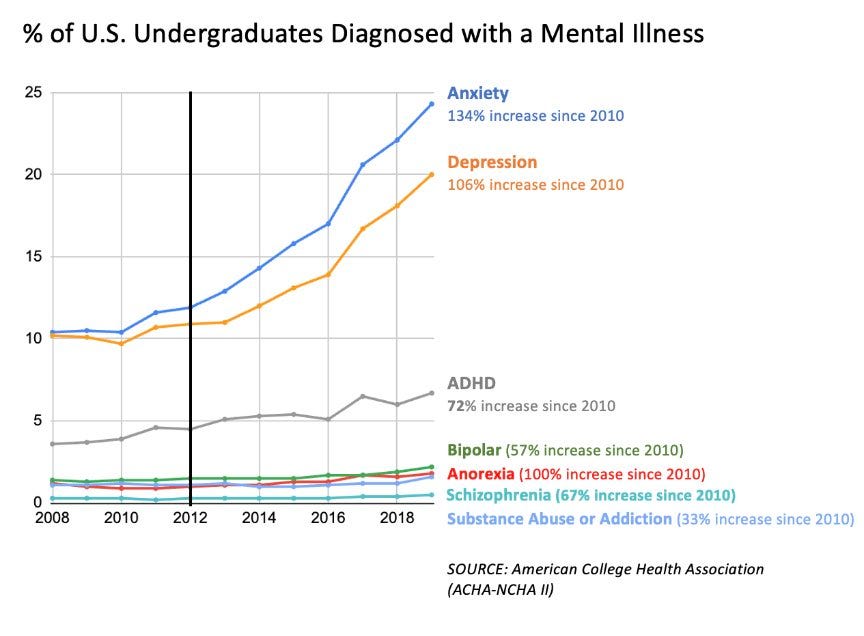The Kids Are Not Alright
Using social media is like learning how to drive, we should ban it before the age of 16 and then require a license
The automobile was invented in the early 20th century. As cars became less expensive and the US road network improved, automobile adoption became more widespread. But along with increased traffic came more and more automobile accidents. People were unfamiliar with how to operate the new technology and the lack of government regulation led to a growing public health problem. By the 1930s many states had drivers licensing exams and age requirements to operate a motor vehicle. By the 1950s, all states required some form of driver’s license.
Social media exploded in the 2010s and is still a lightly regulated space. Intuitively, we know it has been unhealthy but now scientific data is beginning to support that intuition. We know that kids are susceptible to the harmful effects of social media and in particular, young girls have seen the worst mental health effects. In this post, I will make the argument for a social media “driver’s license”. If the observed mental heath trends among Millennials and particularly Gen Z continue, our entire society risks becoming even more of a dumpster fire than it already is.
Harms of Social Media
The social scientist Jonathan Haidt is undertaking important work on the effects of social media on society. All across the Western world, increases in mental illness among adolescents beginning around 2012 have been observed. In 2012, Instagram was launched along with the first iPhone with a front-facing “selfie” camera. This trend is consistent among a variety of countries and data sources.
Figure 1: Mental illness among undergrads
There are two anti-social behaviors that social media promotes to note. First, the desire for “likes”. Users often infer their own popularity based on how many likes their post receives. Posted content is influenced by this dynamic and the wait for likes can be anxiety-inducing. Second, to get likes, users often post the best moments of their life. This often presents an unrealistic slice of life, which can depress a normal, plain person scrolling through posts. Their life is boring by comparison, but the infinite scroll is an unrealistic comparison.
Canaries
Coal miners used to carry caged canaries into mines with them. If the canaries died, the miners knew that poisonous gas was present and turned around before it was too late. Generation Z, born between 1997 and 2012 are our societies canaries. The rates of mental illness among them are greater than among Millennials (born 1981-1996), which are greater than Gen X (born 1965-1980), and so forth. Gen Z and future generations will be less successful as adults, harming our entire society, if current trends continue without new laws.
Figure 2: Anxiety rates among generations
Recommended Policy
There are three recommended immediate policies to address social media harms among adolescents:
1. Require a social media “driver’s license”
2. Conduct government Public Service Announcement (PSA) campaigns
3. Ban smartphones in the classroom
First, just like teens are required to demonstrate certain knowledge before operating a motor vehicle, social media platforms should require a unique ID to open an account. IDs should only be granted to those over the age of 16, though different states can determine their own limits. The authentication of users would also cut down on the amount of spam, bots, and other malicious content online. The current system of voluntary age requirements online can, and often are, defeated by false responses. Detractors to this proposal may decry excess government regulation and state that private social media platforms can do as they wish. But the status quo has created a public health crisis that only the government can solve, like motor vehicle licenses with cars or the Federal Aviation Administration with air travel.
Second, state or federal government agencies should conduct PSA campaigns about the harmful effects of social media. Campaigns against drunk driving or texting while driving are successful models.
Third, smartphones should be banned in all public K-12 classrooms. Test scores were already dropping before COVID lockdowns severely damaged educational outcomes. It’s common sense that smartphones are a distraction and we should take the easy step of banning them from the classroom.
In case you missed it - Ad Astra online
Russian Insurrection: Fog of War
Coming Soon on Ad Astra: Education in America
Banning smartphones in the classroom is an easy first step to improving public education and opportunity in the US. Another factor is the US Supreme Court’s recent ban on affirmative action in college admissions. The change will affect less than 1% of students that attend elite schools in America. However, it will not affect K-12 education, the education level obtained by 52% of Americans[i]. Ad Astra has already outlined the social problems of our student debt crisis and a culture of credentialism in a previous post. This fall, we will further explore education and opportunity in America.
[i] 2020 US Census







